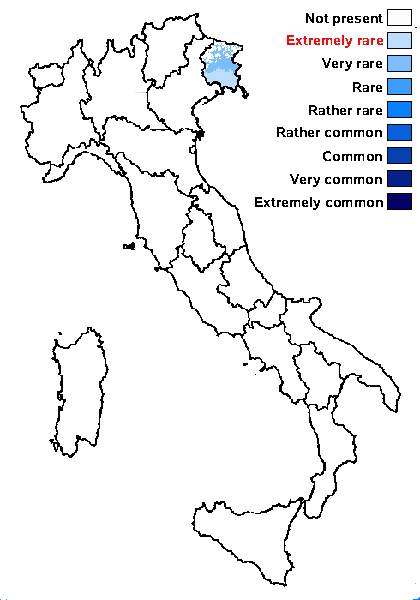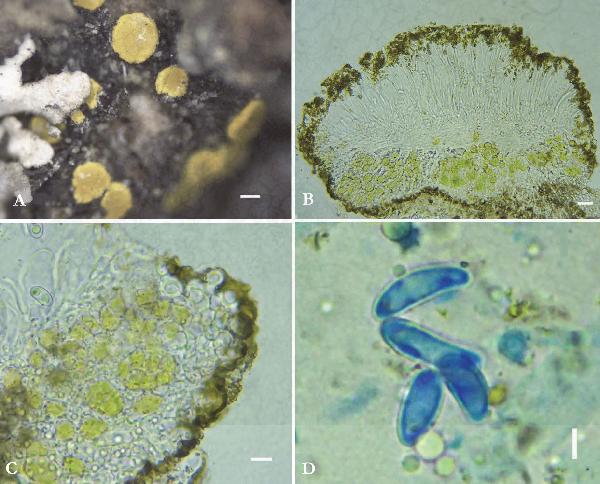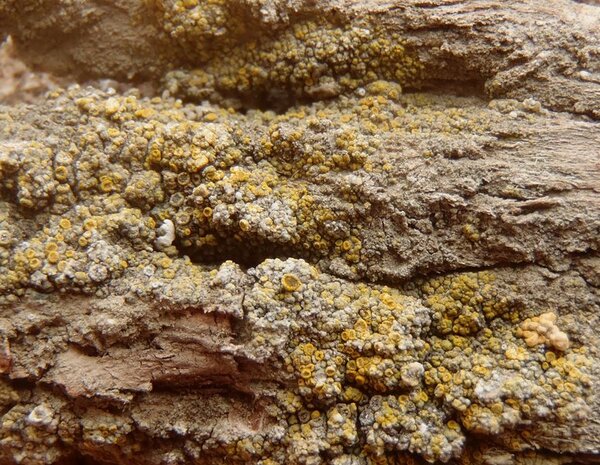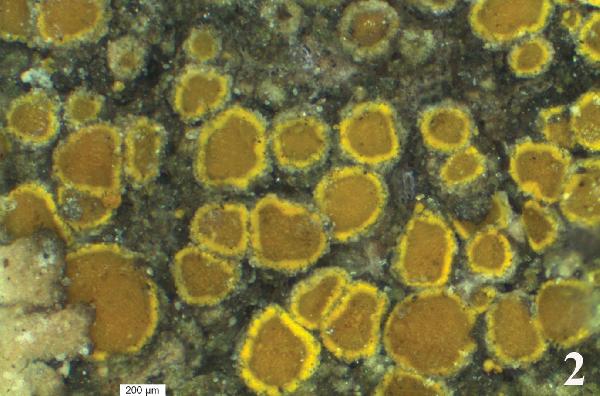Candelariella antennaria Räsänen
Anal. Soc. Cient. Argent., 128, 3: 137, 1939.
Synonyms:
Distribution: N- Frl (TSB 1564),
Description: Thallus crustose, whitish to dark grey, indistinct or somewhat granular, sometimes occurring only around the apothecia, the granules (when present) 0.1-0.2 mm in diam., sometimes developing into 0.2-0.5 mm wide, irregularly shaped, adpressed and flattened, scattered or coalescing areoles. Epinecral layer 10–25 µm thick, of dead compressed hyphae; cortex not clearly developed or to 15 µm thick and then ± pseudoparenchymatous, of gelatinized hyphae with 3-7 µm wide, more or less isodiametrical cells. Apothecia lecanorine, yellow, adnate to slightly constricted at base, 0.2-0.7(-1) mm across, with a rounded to angular, flat to slightly convex, ochre-yellow to yellow disc, and a paler yellow (often greyish in outer side), persistent, smooth, entire to slightly incised, 0.025-0.05 mm thick margin. Thalline exciple with a 4-18 μm thick, indistinct cortex of 1-2(-3) cell layers, of thin-walled, isodiametrical cells, covered with a layer of yellowish-brown, angular crystals; proper exciple prosoplectenchymatous, of branched, radiating hyphae, 27-40 μm wide in uppermost part, with rectangular cells; epithecium yellow-brown, with angular crystals; hymenium colourless, inspersed with oil droplets, 50-75 μm high, I+ blue; paraphyses simple or sparingly branched, 1.5-2 μm thick at mid-level, the apical cells 3–7 μm wide; hypothecium colourless, with oil droplets, 20-50 μm high, not forming a stipe penetrating into the algal layer. Asci 8–spored, clavate, with an apical dome which is I+ blue only in the internal, lower part, interrupted in the centre by a I+ paler blue strip, Candelaria-type Ascospores 1-celled (rarely a few 1-septate), hyaline, straight to slightly curved, oblong to narrowly ellipsoid (11-)12-17(-20) x (4-)5-6(-7) μm. Pycnidia rare, appearing as yellow spots or warts. Conidia ellipsoid to oblong, 2.5-3 x c. 1.5 µm. Photobiont chlorococcoid, the cells 5-20 μm in diam. Spot tests: thallus K-, C-, KC-, P-; apothecia K- or K+ weakly reddish orange. Chemistry: apothecia with calycin, pulvinic dilactone, vulpinic and pulvinic acids.Note: a species growing on bark, mostly of isolated trees (e.g. along waysides), easily confused with epiphytic samples of C. aurella; probably more widespread in Italy.
Growth form: Crustose
Substrata: bark
Photobiont: green algae other than Trentepohlia
Reproductive strategy: mainly sexual
Commonnes-rarity: (info)
Alpine belt: absent
Subalpine belt: absent
Oromediterranean belt: absent
Montane belt: absent
Submediterranean belt: very rare
Padanian area: extremely rare
Humid submediterranean belt: very rare
Humid mediterranean belt: absent
Dry mediterranean belt: absent

Predictive model

Chantal van Haluwyn - Source: M. Bertrand & al. (2023). Lichens nouveaux ou intéressants pour la flore française. Bull. Assoc. Fr. Lichénologie, 2023, 48(1)
FRANCE, massif de l’Ubaye, Saint-Paul-sur-Ubaye, Maljasset, ripisylve immédiatement sous le hameau de Maljasset, alt. 1903 m, 25/07/2014, leg. A B C D Bertrand et al. : Lichens nouveaux ou intéressants... - 57 - C. van Haluwyn, det. M. Bertrand, conf. M. Westberg. C. Van Haluwyn n° 1593
A. Apothécies à rebord thallin non visible car repoussé en dessous. B. Coupe d’apothécie observée dans l’eau. C. Amphithécium en coupe transversale radiale. D. Spores ellipsoïdales, colorées au bleu coton. Barre d’échelle : A, 0,15 mm ; B, 20 µm ; C–D, 5 µm
Growth form: Crustose
Substrata: bark
Photobiont: green algae other than Trentepohlia
Reproductive strategy: mainly sexual
Commonnes-rarity: (info)
Alpine belt: absent
Subalpine belt: absent
Oromediterranean belt: absent
Montane belt: absent
Submediterranean belt: very rare
Padanian area: extremely rare
Humid submediterranean belt: very rare
Humid mediterranean belt: absent
Dry mediterranean belt: absent

Predictive model

 INDEX FUNGORUM
INDEX FUNGORUM
 GBIF
GBIF
 DOLICHENS
DOLICHENS




